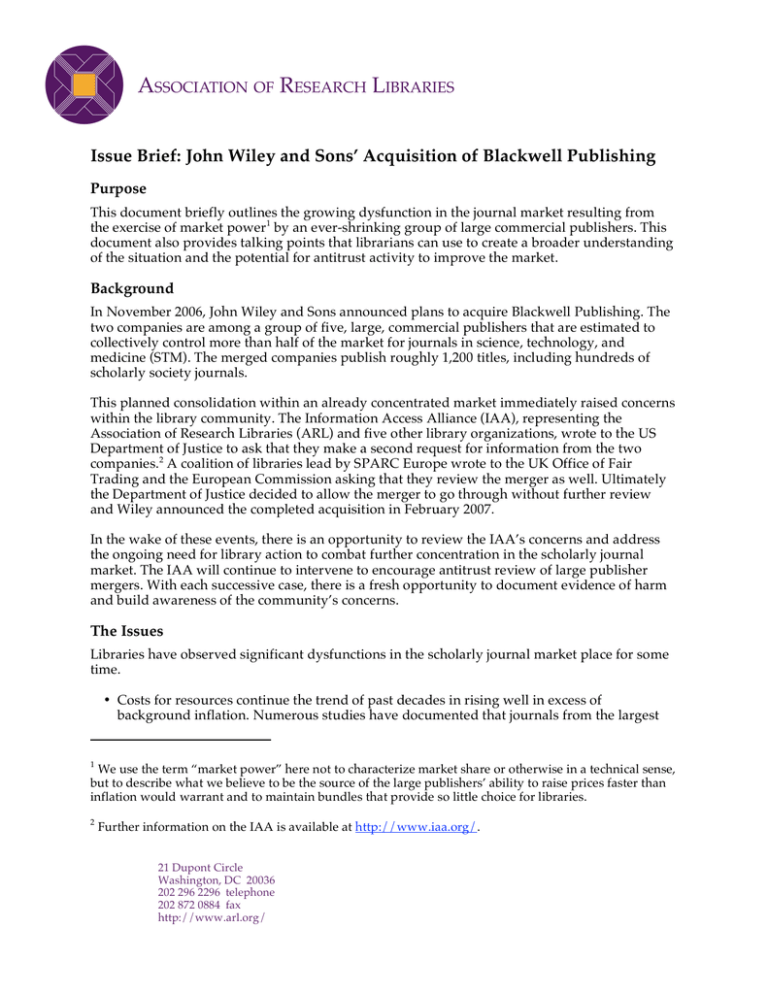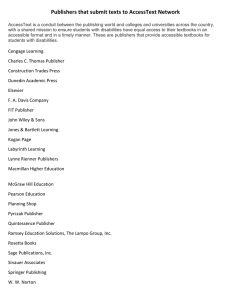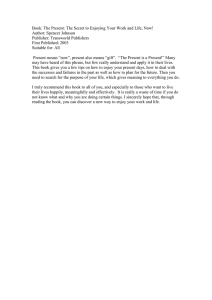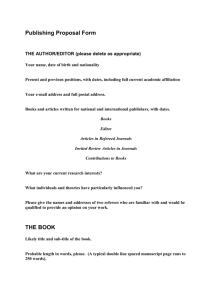Issue Brief: John Wiley and Sons` Acquisition of Blackwell Publishing
advertisement

Issue Brief: John Wiley and Sons’ Acquisition of Blackwell Publishing Purpose This document briefly outlines the growing dysfunction in the journal market resulting from the exercise of market power1 by an ever-shrinking group of large commercial publishers. This document also provides talking points that librarians can use to create a broader understanding of the situation and the potential for antitrust activity to improve the market. Background In November 2006, John Wiley and Sons announced plans to acquire Blackwell Publishing. The two companies are among a group of five, large, commercial publishers that are estimated to collectively control more than half of the market for journals in science, technology, and medicine (STM). The merged companies publish roughly 1,200 titles, including hundreds of scholarly society journals. This planned consolidation within an already concentrated market immediately raised concerns within the library community. The Information Access Alliance (IAA), representing the Association of Research Libraries (ARL) and five other library organizations, wrote to the US Department of Justice to ask that they make a second request for information from the two companies.2 A coalition of libraries lead by SPARC Europe wrote to the UK Office of Fair Trading and the European Commission asking that they review the merger as well. Ultimately the Department of Justice decided to allow the merger to go through without further review and Wiley announced the completed acquisition in February 2007. In the wake of these events, there is an opportunity to review the IAA’s concerns and address the ongoing need for library action to combat further concentration in the scholarly journal market. The IAA will continue to intervene to encourage antitrust review of large publisher mergers. With each successive case, there is a fresh opportunity to document evidence of harm and build awareness of the community’s concerns. The Issues Libraries have observed significant dysfunctions in the scholarly journal market place for some time. • Costs for resources continue the trend of past decades in rising well in excess of background inflation. Numerous studies have documented that journals from the largest 1 We use the term “market power” here not to characterize market share or otherwise in a technical sense, but to describe what we believe to be the source of the large publishers’ ability to raise prices faster than inflation would warrant and to maintain bundles that provide so little choice for libraries. 2 Further information on the IAA is available at http://www.iaa.org/. 21 Dupont Circle Washington, DC 20036 202 296 2296 telephone 202 872 0884 fax http://www.arl.org/ commercial publishers cost many times more than comparable journals from not-for-profit publishers. In addition, prices rise more rapidly following large acquisitions. • A spiral of rising prices and ongoing market concentration squeezes out support for small society journals. • It is very difficult for other publishers to start new scholarly journals in the current marketplace. • The advent of electronic journal formats and large publisher bundles have increased the ability of merging companies to exercise market power to raise prices and direct compensatory cancellations onto other publishers’ journals. It is important for the dysfunctions created by the exercise of market power to be understood more broadly—not just by librarians, but also by researchers, scholarly society leaders, and the small publishers being hurt by spiraling price increases and cancellation protection afforded by bundling practices. Antitrust authorities can intervene in future mergers either to impose conditions making it less likely that the merger will be damaging to customers or to block the acquisition. Because the large publishers operate in a global market, both US and European regulators can choose to intervene in large acquisitions. Regulators respond most actively when customers express concerns clearly and consistently. The library community must continue to make its voice heard. Talking Points History shows that mergers of large journal publishers lead to price increases. Over the past decade many analyses have documented the price increases that typically accompany mergers. Other studies have reported that Blackwell titles on average have offered substantially lower prices than the other four large journal publishers. This means that there may be an unusually attractive opportunity for increases to bring former Blackwell titles to levels that are more similar to the norms for Wiley and other large publishers. The library community can show the effects of these events on prices and other contract terms. Rumors of large publisher mergers continue to appear in the business press. The execution of the Wiley/Blackwell merger could be seen as encouragement to other large publisher acquisitions. By maintaining and publicizing records of publisher price patterns, libraries can share evidence from their own purchase histories with society members, editors, and antitrust authorities that illustrates the adverse effects of consolidation of large publishers. Currently Elsevier, Springer (holding the former Kluwer journals), Wiley/Blackwell, and Taylor and Francis are substantially larger than other scholarly journal publishers and have been reported by industry analysts to collectively control more than half of the market for science, technology, and medicine journals. Large publisher mergers mean mergers of journal bundles, increasing strains on the market. Wiley and Blackwell largely share the customer base for their bundles. Following previous mergers such as Academic with Elsevier and Springer with Kluwer, the merging companies reduced their duplication of infrastructure within two years by merging their bundles (without Page 2 of 4 any commensurate reductions in prices). ARL’s member survey3 found that Wiley contracts typically had terms of three years or more while Blackwell contracts were frequently annual. With the high rate of overlap and usually shorter term of Blackwell contracts, it seems reasonable to anticipate that the bundles will be merged as the shorter Blackwell contracts expire. Concentration in the market creates barriers to sustainability for small publishers. The effects of big mergers extend beyond the titles immediately controlled by the merging firms. As ever-larger companies exercise ever-greater market power, libraries increase journal cancellations. Very often the titles that are cancelled are not the ones with big price increases. Instead many inexpensive journals from small publishers may be cancelled to cover a large price increase in a single title offered by a large commercial publisher. In this way, small publishers find themselves facing a shrinking subscriber base even when they maintain their journal prices. Bundling significantly magnifies the ability of large publishers to exercise this kind of market power. By making protection from cancellation a feature of their e-journal bundles, they virtually guarantee that other publishers’ titles will be cancelled when the library budget fails to keep up with inflation. The ARL’s 2006 survey of members’ publisher bundles found that in the previous three years 60% of the members had carried out serial cancellations and, of those, more than two-thirds had protected at least one large publisher bundle. Concentration in the market creates barriers to entry for new titles. Over time, it becomes harder and harder for libraries to support new and unproven titles— unless, of course, they are included in a bundle. Price increases for new content combine with super-inflationary increases in established content to allow the bundle to tie up funds that might otherwise support new competitors for the large publishers. Publishers without similar market power are shut out. Scholarly societies may have opportunities to evaluate their existing arrangements with publishing partners. Faculty and editorial activism could be opportune. Societies, their leaders, members, and journal editors should monitor the price history and sales of their society journals. Significant increases in price are likely to lead to significant reductions in subscriptions and inevitably readership. Broad and sustainable access to scholarship is a concern shared by libraries and scholarly societies. Many, maybe most, former Blackwell clients have contract clauses allowing them to choose new publishing partners in the case of a sale of Blackwell. Such clauses should prompt society publishers to evaluate the performance of their Blackwell contract and the likelihood that Wiley will be able to meet the full range of the society’s publishing goals, not just revenue generation. 3 See Karla Hahn, “The State of the Large Publisher Bundle: Findings from an ARL Member Survey,” ARL: A Bimonthly Report, no. 245 (April 2006): 1–6, http://www.arl.org/bm~doc/arlbr245bundle.pdf. Page 3 of 4 Antitrust enforcement can help restore balance to the market. While market power in and of itself is not illegal, large mergers and acquisitions do undergo review to determine if they will substantially reduce competition in the market. The European Commission intervened in a proposed merger of Elsevier and Kluwer titles in 1998 to prevent this kind of market concentration. It is also possible for specific publisher practices to draw antitrust scrutiny if they might be restraining trade. Illegal exercise of market power through product bundling is possible. The Department of Justice suit against Microsoft was based on Microsoft’s practices of bundling together browser software and their operating system. Bundling is an evolving area of antitrust law and companies in a variety of industries may be straying into illegal or at least questionable practices. Volume discounting is not the issue; rather the problem is the way products are tied together in some new forms of bundling. Antitrust scrutiny is typically initiated in response to customer complaints. Without ongoing expressions of concern, there is an assumption that a market is working properly. Customer communities need to document and report their concerns. The more clearly the effects of anticompetitive practices and market concentration can be demonstrated, the more likely it is that antitrust officials will decide to take a closer look at a market and its large players. Once an investigation or intervention is initiated, there are many potential positive outcomes for customers. Further mergers and acquisitions may be discouraged. Large companies may be forced to divest parts of their portfolios to increase competition. Disclosure practices can be required—for instance, non-disclosure can be barred or public posting of product prices mandated. Anticompetitive practices can be restricted—for instance, multiyear contracts or limits on cancellation could be banned. Mergers provide an opportunity to draw attention to our concerns regarding large journal publishers and to gather further evidence of the harm being done by market concentration and bundling practices. For more information contact: Karla Hahn, Director, Office of Scholarly Communication, ARL, karla@arl.org Page 4 of 4






